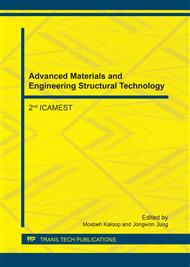p.290
p.296
p.302
p.308
p.313
p.318
p.324
p.330
p.336
The Influence of the Water/Cement Ratio in the Open Porosity and in the Carbonation Front Advancing in Cementitious Matrix Composites
Abstract:
In this study involving cementitious matrix composites, the influence of the water/cement (w/c) ratio variation (0.48, 0.60, 0.70 and 0.75) was analyzed in its open pore structure and in the carbonation front advancing. Test specimens were molded in cylindrical dimensions of (5x10) cm and (2x4) cm for each mix proportions, and subjected into accelerated carbonation tests, at controlled exposure conditions. The open porosity of the material was obtained by using a helium pycnometer. A model based on Fick's second law was used to fit an equation to the curve of progress of the carbonation front over time. The results show that the water/cement ratio can highly influence the analyzed properties; the mathematical model used provided an excellent approximation of the advancing carbonation front trend, allowing a good evaluation of the carbonation coefficient (K) associated to each mixture proportioning.
Info:
Periodical:
Pages:
313-317
Citation:
Online since:
April 2017
Keywords:
Price:
Сopyright:
© 2017 Trans Tech Publications Ltd. All Rights Reserved
Share:
Citation:


